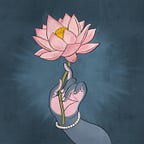Narasiṁha and His Significance to the Bhakta
Excerpt from Songs of Three Great South Indian Saints by William J Jackson
“Lord Narasimha, you are cosmic existence
the stars are your waistband
sun and moon your eyes, sunrays your spears
Vedas are your shaggy mane
mountains your feet, earth your thighs
time cycle your mouth, planets your teeth
the whole sky is just your waist
the seas are your nectary grace
thunder’s your roar, Venkatadri your cave.”
Annamācārya, the 16th century Telugu composer devoted to Lord Venkateśvara at Tirumala, thus described Narasiṁha. In the story of Pahlāda and Hiraṇyakaśipu, the need for a divine force to set things right when the demonic have sovereignty might be like a Hindu desire for the power to enter the invaders’ stronghold and, amid ominous signs of catastrophe claw open the chest of the powerful ruler and rip out his entrails, to protect Hindu devotees from demonic force. The loving trust of the bhakta brings out the grace that destroys the demon threatening the survival of those relying on Vishnu the preserver.
At first the inert pillar’s potential for a ferocious explosively leaping force seems ridiculously small — negligible as the presence of God in matter seen by materialist eyes. The divine takes on just the right form to change everything. Power is concealed, not seeming there on the surface, but able to burst through, emerging to take away the too powerful enemy who disturbs the world, and save the true-hearted one. And the faithful devotee can see through the eye of bhakti the whole cosmos in this twilight epiphany, the theophany of death, planets, divine beings; and meditating on this vision, the devotee becomes wise.
A reversal is enacted and so while the ruler seemed so great and the invisible Lord seemed so small, the reality turned out to be laughably and weepably otherwise. The Narasimha scenario teaches that where human and holy meet (at thresholds), God’s presence overpowers little creatures: at twilight, at the moment of birth, at the moment of death, between sleep and waking, mind and soul, between breaths and thoughts, at the seams of the seasons (New Year, Holy day festivals, celebrations where the usual barriers are down). God’s supremacy becomes apparent, the story asserts, and even the atheist at the moment of death meets a transcendent force he cannot deny. Though the self-centred atheist makes his soul as dry as a desert, yet in the desert the lion rages and in the end moment of mortality, the turning point of losing all, the liberating beauty of the sacred frees the tyrant from his ego and his suppression of others” hearts.
Vishnu is the lion of power who battled the demons. This fierce deity shows up in the ongoing cosmological context with its periodic degenerations, as the answer to the fix the devoted are in — the only way out. Vishnu is time itself, with its inevitable re-occurrences. Because his appearance is cyclical, rhythmic, he is present in the transitional times between destruction and reconstruction, he has the potency for change with him. Devotees rely on chis world-view, in their communitas (extraordinary experiences of sharing common bonds in devotional practices). Vishnu’s avatar power mediates amidst cosmic forces. When the godly are imperilled he finds a loophole, and with cunning slips through, elusive but uneludable as a thunderbolt made of foam, earthshaking primal power in a dark cloud. He is a much needed more fierce, potential, able to spring out and overpower the human ego that threatens. The antithesis of a tamasic sluggish, weak, hopeless victim, Narasiṁha answers a deep hope for a raging energy, an uncontrollable divine irrational overpowering; the awakening of the latent spirit with all its energy, able to activate the hidden forces, make them patent, addressing dangers, allaying fears.
The oppressive enemies find themselves overcome by a greater power which they disregarded- even the materialist at death is overcome by power beyond his control. The terrifying Narasiṁha is ‘a Shiva-esque Vishnu’ his pillar is a liṅga, a sacrificial post, a centre of the universe.
In the story, the riddle of the demon king’s boon to be invulnerable in wet or dry, night or day, in or out, for man or beast, is solved by the killer who transcends all dualities: wild Lord Narasiṁha. Kanakadāsa sang dramatically picturing the shocking outburst:
“I saw the gods assembled in the heavens
I saw the mighty foe
fierce and valiant Narasiṁha
I heard the crack of lightning rumbling in the pillar
and saw sparks fly out. The assembled onlookers
were all stunned — their stance was shaken, and they
covered their heads they were so terrified. I saw …
The Lord gripped his enemy’s chest and tore open his abdomen; easily he pierced it, ripped off skin this way and that.
He tore out veins and bones, the blood was spurting forth and he garlanded himself with his foe’s intestines. I saw …
Townspeople shrieked in shock, gods tossed a rain of flowers,
musical instruments played. ‘We take refuge in you Hari!’
they chanted; child Prahlāda glowed jubilantly, praising the name of the merciful Lord Ādikeśava of Kaginele. I saw …”
Except from: Songs of Three Great South Indian Saints by William J Jackson
_________________________________________________________
If you find value in my work, I hope you consider becoming a patron or making a contribution via UPI to hindu.aesthetic@okicici. Hindu Aesthetic requires a lot of time and effort and your support would mean that I can continue bringing you the best possible content. ❤
